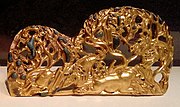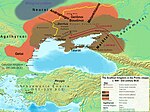The Sauromatian culture (Russian: Савроматская культура, romanized: Savromatskaya kulʹtura) was an Iron Age culture of horse nomads in the area of the...
56 KB (6,257 words) - 14:27, 2 November 2024
Sarmatians (redirect from Sarmatian culture)
Sarmatian and Sauromatian, modern authors distinguish between the two, since Sarmatian culture did not directly develop from the Sauromatian culture and the...
81 KB (8,706 words) - 12:30, 17 November 2024
southern Urals, where they contributed to the development of the Sauromatian culture. Characteristic finds are bronze arrowheads, daggers and belt ornaments...
14 KB (1,272 words) - 08:53, 14 October 2024
flat graves. The Late Scythian culture ended in the middle of the 3rd century AD. Maeotian culture Sauromatian culture Ivantchik 2018. Alekseyev, Andrey...
95 KB (13,137 words) - 20:07, 13 October 2024
Scopasis (category Sauromatian culture)
Scopasis (Ancient Greek: Σκώπασις Skṓpasis) was a 6th-century BC Scythian king of the Sauromatae tribe. The Greek historian Herodotus mentions him in his...
2 KB (158 words) - 18:35, 28 October 2024
Pazyryk culture Khotan Uyuk culture Tagar culture Massagetae Kangju Subeshi culture Ordos culture Sargat culture Tasmola culture Sauromatians Dahae Indo-...
438 KB (53,491 words) - 20:19, 16 November 2024
Filippovka kurgans (category Sauromatian culture)
Filippovka kurgans (Ru: Филипповский курганный) are Late-Sauromatian to Early-Sarmatian culture kurgans, forming "a transition site between the Sauromation...
20 KB (1,888 words) - 20:44, 5 March 2024
Saka (redirect from Saka culture)
which was assimilated into the Sauromatian and Early Sarmatian cultures. Circa 600 BCE, groups from the Saka Tasmola culture settled in the southern Urals...
198 KB (21,810 words) - 13:30, 11 November 2024
Scytho-Siberian world (redirect from Scytho-Siberian culture)
It included the Scythian, Sauromatian and Sarmatian cultures of Eastern Europe, the Saka-Massagetae and Tasmola cultures of Central Asia, and the Aldy-Bel...
63 KB (7,323 words) - 23:53, 6 July 2024
Riphath (category Sauromatian culture)
called Paphlagonians". Hippolytus of Rome made him the ancestor of the Sauromatians (as distinct from the "Sarmatians", whom he called descendants of Riphath's...
3 KB (350 words) - 09:45, 19 December 2023
Taksai kurgans (category Sauromatian culture)
(more precisely Taksai-1, Ru: Таксайский курган) are a series of Saka or Sauromatian funeral mounds or kurgans, located in the Terekti District of the southern...
8 KB (868 words) - 15:50, 28 September 2024
The Sintashta culture is a Middle Bronze Age archaeological culture of the Southern Urals, dated to the period c. 2200–1900 BCE. It is the first phase...
46 KB (4,908 words) - 14:33, 20 October 2024
Timber-grave culture, was a Late Bronze Age 1900–1200 BC culture in the eastern part of the Pontic–Caspian steppe. It is a successor of the Yamna culture, the...
16 KB (1,630 words) - 04:49, 24 October 2024
The Mezhovskaya culture (mistranscribed as Meshovskaya culture) is an archaeological culture of the late Bronze Age (13th to the beginning of the 7th century...
8 KB (909 words) - 23:32, 28 September 2024
society structure. There are societies where the roles are switched. The Sauromatian society's women were highly respected warriors. Their graves were full...
18 KB (1,994 words) - 07:04, 10 September 2024
Chernogorovka-Novocherkassk complex (redirect from Cernogorovka culture)
which also later participated other Iranic nomads such as the Scythians, Sauromatians, and Sarmatians. The formation of genuine nomadic pastoralism itself...
18 KB (2,018 words) - 06:28, 29 October 2024
Siberia, or the gold-inlaid plates of the Tasmola culture, as far as the southern Urals in the Late-Sauromatian Filippovka kurgans. "Animal style" deer, (7-6th...
36 KB (4,025 words) - 22:21, 24 October 2024
Androphagi (section Society and culture)
of the earliest burials of the Tiasmyn group of the Scythian culture. The Sauromatians who lived in the Urals and the lower Volga, and Massagetae and...
19 KB (2,047 words) - 20:20, 28 October 2024
bank of the Kuban river were abandoned in the 4th century BC, when the Sauromatians took over most of Ciscaucasia, the Sindi built a new series of earthworks...
10 KB (830 words) - 08:59, 25 October 2024
the ethnonym of the Sairimas has been connected to the Sarmatians and Sauromatians. Likewise, the ethnonym Dahi may be related to Dahaes. Gnoli 1980, pp...
20 KB (2,355 words) - 15:55, 2 October 2024
Cimmerians (redirect from Kimmerian culture)
to the 1st millennium AD. Other Iranic nomads, such as the Scythians, Sauromatians, and Sarmatians, would later follow. The formation of genuine nomadic...
169 KB (20,510 words) - 14:27, 14 November 2024
Agathyrsi (section Culture and society)
participated other Iranic nomads such as the Cimmerians, Scythians, Sauromatians, and Sarmatians. The archaeological and historical records regarding...
44 KB (4,875 words) - 12:22, 25 October 2024
Avestan period (section Culture)
Iranians divided the land between three sons: Sairima, the forefather of Sauromatians (who dwelt in the historic period from the Don to the Urals), Tur, from...
67 KB (8,440 words) - 09:17, 2 November 2024
Sigynnae (section On the Hallstatt culture)
participated other Iranic nomads such as the Cimmerians, Scythians, Sauromatians, and Sarmatians. The formation of genuine nomadic pastoralism itself...
37 KB (4,556 words) - 06:25, 29 October 2024
were Ashkenaz, from whom descended the Sarmatians, Riphath, whence the Sauromatians [Soramatk'], and Togarmah, who according to Jeremiah subjugated the Ashkenazian...
14 KB (1,809 words) - 07:36, 24 October 2024
the Oxus river. The Sairimas have been connected to the Sarmatians and Sauromatians based on linguistic similarities. Likewise, the Dahas may be related...
37 KB (4,200 words) - 23:48, 2 November 2024
his belt. Beginning in the 5th century BC, the influence of arriving Sauromatians from the east, the borrowing of elements from Thracian art as well as...
50 KB (5,835 words) - 19:57, 17 September 2024
Crimean steppe [...] The eastern neighbours of the "Royal Scyths," the Sauromatians, were also Iranian; their country extended over the steppe east of the...
18 KB (2,014 words) - 15:49, 29 October 2024
chronicle the existence of the Massagetae and Sauromatians, and later, the Sarmatians and Sacae: cultures possessing artefacts similar to those found in...
40 KB (4,154 words) - 22:56, 29 October 2024
treatise Des airs, des eaux et des lieux (Of Airs, Waters and Places), Sauromatian (Sarmatian) women were as warlike as men, rode horses, and had their...
98 KB (12,128 words) - 10:32, 7 November 2024



















